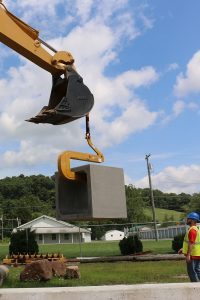It’s a Tough Job – Gravestones and the Monument Lift
Selecting a monument is a demanding process within itself, so why should setting it in place it be? Most people probably don’t think much about what happens at the cemetery after you kick the bucket. Honestly, I don’t even want to consider any of the details! (Yikes!) Once you have been laid to rest, some type of grave marker needs to be placed to designate this new “home away from home” as your final resting place. Amazingly enough, it doesn’t magically appear there like elves hiding gifts. Sorry no elves here! Pardon me. Let me get serious for a moment. It is possibly the awkwardness of this discussion that is getting to me. So respectfully, I will move on…
Cemetery workers have the job of preparing and maintaining the memorial grounds where our loved ones have been laid to rest. They must mark each and every site with a grave marker or monument, often times without additional help. These granite monuments are heavy and often require more strength than a single person can muster. Kenco offers a couple of gravestone handling and monument lifting solutions. One is a smaller version of our well-established barrier lifter called the Kenco Monument Lift, while the other is our scaled down Multilift.
The Monument Lift has a 1500 pound capacity and can be attached to a mini excavator, skid steer or any other machine with lifting capabilities. The granite can be moved from the delivery location to the grave site safely, with little interruption to the surrounding landscape. A grip range of 3 to 12 inches is suitable for the majority of typical monument sizes. Non-marring elastomer pads provide a secure grip on the polished stone. In addition, a rubber pad cushions the top of the stone.
Another alternative is the Multilift, which can be attached to any of those same machines. It boasts a 3000 pound capacity, plus the legs can be manually adjusted to grab from 5 to 32 inches in width. It also has the same non-marring elastomer pads to ensure a tight grip and prevent damage to the polished surface.
Either of these Kenco lifting products will streamline the process and allow a single person to do the job without worry of damage to the granite, therefore saving the workers’ back in the process.




